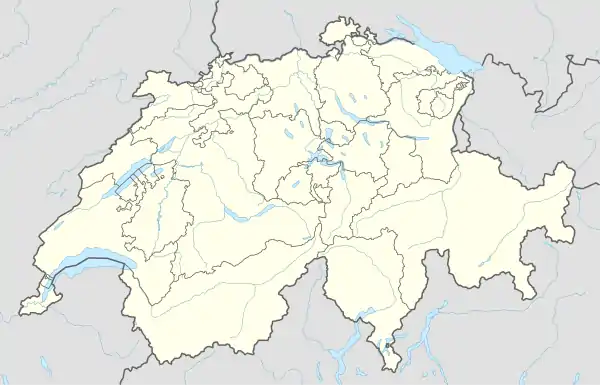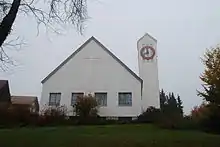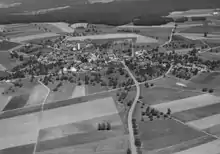Truttikon
Truttikon is a municipality in the district of Andelfingen in the canton of Zürich in Switzerland.
Truttikon | |
|---|---|
 | |
 Coat of arms | |
Location of Truttikon 
| |
 Truttikon  Truttikon | |
| Coordinates: 47°38′N 8°44′E | |
| Country | Switzerland |
| Canton | Zurich |
| District | Andelfingen |
| Area | |
| • Total | 4.42 km2 (1.71 sq mi) |
| Elevation | 465 m (1,526 ft) |
| Population (2018-12-31)[2] | |
| • Total | 477 |
| • Density | 110/km2 (280/sq mi) |
| Time zone | UTC+01:00 (Central European Time) |
| • Summer (DST) | UTC+02:00 (Central European Summer Time) |
| Postal code(s) | 8467 |
| SFOS number | 0041 |
| Localities | Burghof, Gisenhard, Hausen bei Ossingen, Langenmoos |
| Surrounded by | Basadingen-Schlattingen (TG), Ossingen, Schlatt (TG), Trüllikon, Waltalingen |
| Website | www SFSO statistics |
Geography


Truttikon has an area of 4.4 km2 (1.7 sq mi). Of this area, 64.2% is used for agricultural purposes, while 28.4% is forested. Of the rest of the land, 7% is settled (buildings or roads) and the remainder (0.5%) is non-productive (rivers, glaciers or mountains).[3]
Demographics
Truttikon has a population (as of 31 December 2019) of 463.[4] As of 2007, 3.2% of the population was made up of foreign nationals. Over the last 10 years the population has grown at a rate of 13.2%. Most of the population (as of 2000) speaks German (95.9%), with English being second most common ( 1.4%) and Italian being third ( 0.5%).
In the 2007 election the most popular party was the SVP which received 41.5% of the vote. The next three most popular parties were the local small left-wing parties (15.7%), the SPS (15.5%) and the FDP (8.8%).
The age distribution of the population (as of 2000) is children and teenagers (0–19 years old) make up 29.7% of the population, while adults (20–64 years old) make up 58.9% and seniors (over 64 years old) make up 11.5%. In Truttikon about 86.3% of the population (between age 25-64) have completed either non-mandatory upper secondary education or additional higher education (either university or a Fachhochschule).
Truttikon has an unemployment rate of 0.77%. As of 2005, there were 71 people employed in the primary economic sector and about 22 businesses involved in this sector. 16 people are employed in the secondary sector and there are 5 businesses in this sector. 22 people are employed in the tertiary sector, with 8 businesses in this sector.[3]
References
- "Arealstatistik Standard - Gemeinden nach 4 Hauptbereichen". Federal Statistical Office. Retrieved 13 January 2019.
- https://statistik.zh.ch/internet/justiz_inneres/statistik/de/daten/gemeindeportraet_kanton_zuerich.html?tab=indikatoren&jahr=2017&indikatoren=133&bfs=41.
- Swiss Federal Statistical Office accessed 28-Jul-2009
- "Ständige und nichtständige Wohnbevölkerung nach institutionellen Gliederungen, Geburtsort und Staatsangehörigkeit". bfs.admin.ch (in German). Swiss Federal Statistical Office - STAT-TAB. 31 December 2019. Retrieved 6 October 2020.